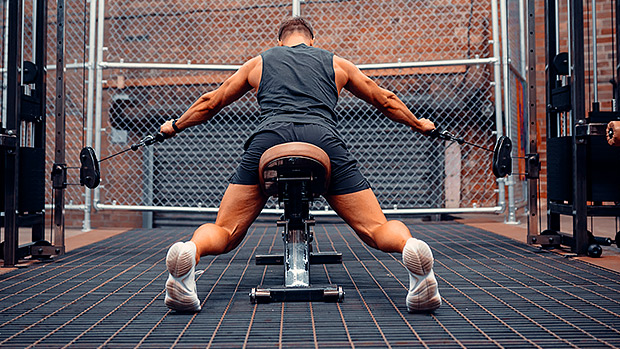If you want your stubborn back to start growing, you need to attack it from all angles. And you need to do it with more focus on tension rather than just how much weight you can throw around. Try these exercises.
- Find the cable setup that's most comfortable and best aligns the force through your elbows, without elbow twisting or pain. Adjust the incline of the bench and distance it sits from the cables to suit this alignment.
- Keep the angle of the pull in mind. It will change the emphasis somewhat. Narrow cables and a neutral grip will target your lats more. Wide cables and more of a palms-down grip will focus more on your teres major and develop the width of your upper back.
- Support your chest on the bench, lock yourself in, and don't let your chest come away from the pad.
- Drive your elbows down toward your back pockets. Get a hard squeeze at the bottom and full stretch as you come back up.
- Be aware of the bench sliding. To stop this, just throw some plates on the floor in front of it.
Why These Work
Eagle pulldowns are essentially a chest-supported lat pulldown using a wider than usual grip. The wider grip is nicely complemented with the cables, as the cables work to load you in the right direction. This is different than what you'd get from an ultra-wide grip on regular pulldowns where the force is coming from a different direction.
Because of the direction of force from the cables, you'll be working a part of your back that usually gets left out in most back workouts. Your bitchy elbows will also enjoy the extra freedom of using two cables instead of a stiff bar.
The chest-supported position helps lock you down and focus on upper back and lat engagement. A belly-down position on a bench gives your low back a break. If you're wanting to save your low back for other exercises – deadlifts, say – chest-supported variations are a good way to manage volume for your hips and spinal erectors. And they're not so taxing on your CNS.
- Position your bench further back from the cables that what you might initially think. The cables should start at the bottom of the stack, but can be adjusted from there depending on the rest of your setup.
- Start light and make micro-adjustments in the setup based on what feels best. Cable height, bench distance, and angle of the bench will vary according to your structure and your equipment design.
- The row should be relatively horizontal in direction. Force of the cable should be directed in a straight line down your elbows – no twisting motions or elbow pain.
- Drive your elbows behind you and pinch your shoulder blades together. Let your shoulder blades do their thing and glide around your ribcage freely.
- If the angle doesn't feel quite right, then keep adjusting the setup until it does. You'll know when.
Why These Work
Spider rows are the more horizontal version of the eagle pulldown. Because of the change in cable height and force alignment, these are more useful as an exercise to hit your rhomboids and mid-traps.
Just like eagle pulldowns, spider rows are chest-supported and more back friendly than bent-over rows. For more targeted volume for your mid-back, spider rows are one to add to the toolbox.
Eagle pulldowns and spider rows work because they offer an alternative angle to more traditional back workouts. Instead of regular lat pulldowns, try using eagle pulldowns for a few weeks.
Seated cable rows are old news! Put a new angle on your horizontal pulls by using spider rows instead. Both of these work well as secondary exercises. Try sets of 12-15 reps.





